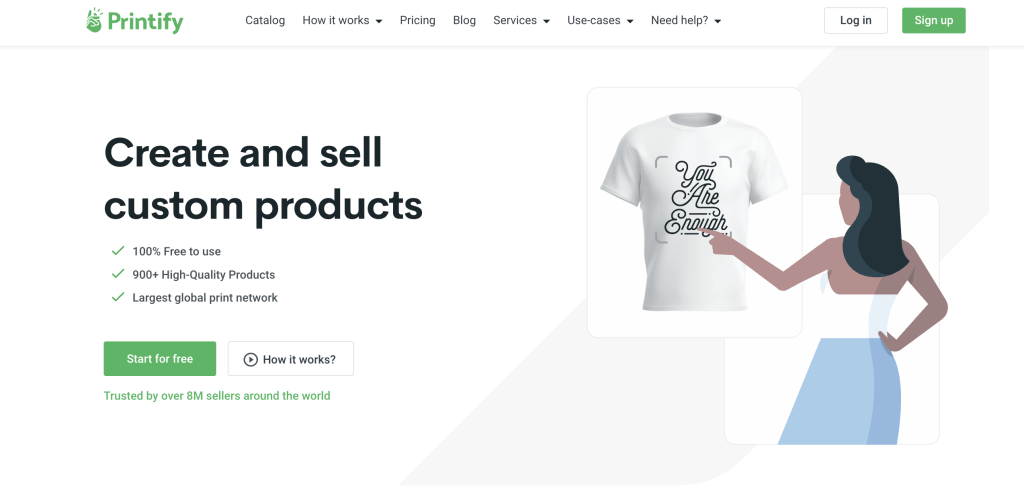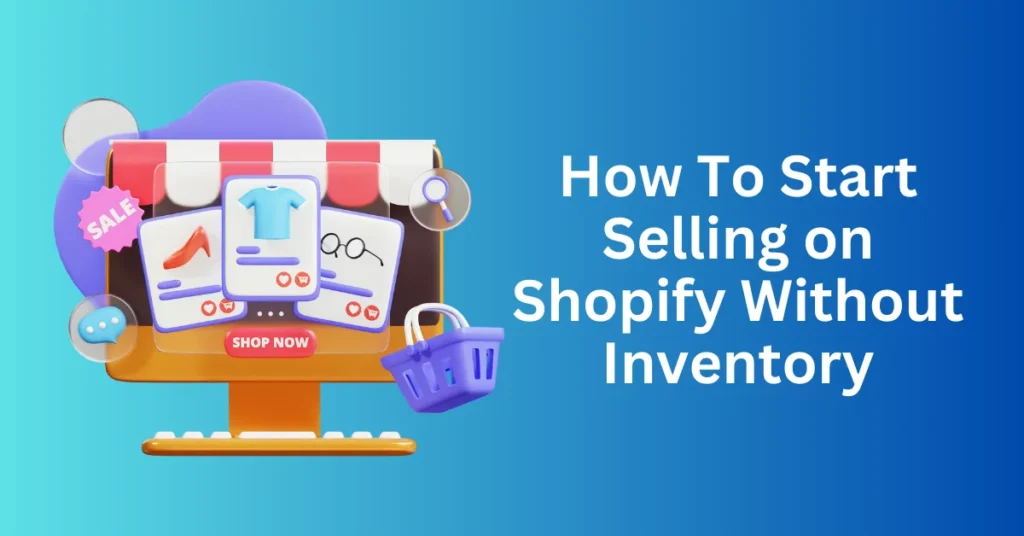Selling products online through traditional production methods demands significant effort. From managing inventory and storage space to crafting engaging product descriptions and effective marketing strategies, not to mention balancing shipping costs and profit margins, the to-do list seems endless. What if you can start your Shopify and start selling without inventory?
Fortunately, there’s a solution to sell on Shopify while bypassing the hassles of physical inventory. While it won’t magically transform running a Shopify store into a leisurely stroll, it certainly streamlines your life.
Numerous methods exist to sidestep the need for maintaining your own inventory, but today, we’ll delve into the four most popular options. By the end of this article, you’ll be well-versed in how to operate a Shopify store without the burden of inventory management.
Start Your Shopify Store Today for Free
How to Sell on Shopify Without Inventory
Indeed, Shopify offers several methods that enable you to build an online business and generate revenue without the hassle of managing any physical product. Here, we’ll delve into 4 popular methods to sell on Shopify without holding inventory: print-on-demand, supplier dropshipping, digital products, and affiliate products. For each method, we’ll provide a brief overview, along with their respective pros, cons, and tips to help you pick the best fit for your business needs.
1. Print-on-demand (POD) – Sell on Shopify Without Inventory
Print-on-demand(POD) is an innovative business model that enables entrepreneurs to personalize products with their own designs. Additionally, a service provider like Printify handles the creation and shipment of these products directly to customers. Consequently, this setup enables you to focus on designing and marketing your products without worrying about the complexities of production and logistics.
To build an ecommerce business using POD, the first step is selecting a reputable print-on-demand service. After choosing a suitable POD provider, the next move is to build your online store on a popular ecommerce platform like Shopify. The online store is then connected to the POD provider, establishing a seamless process from order to delivery.

As a business owner, your responsibilities include creating unique designs, marketing your products, and developing a strong brand identity. Meanwhile, your POD provider manages the production and shipping aspects. When a customer makes a purchase from your store, the POD service produces the item and ships it directly to the customer, ensuring a smooth and efficient transaction.
Opting for a print-on-demand company like Printify, which operates on a private-label basis, offers significant branding advantages. In this arrangement, you sell white-label products, meaning that everything is branded under your business name. Printify’s branding remains invisible throughout the process. This allows you to put your logo on labels, packaging, and even the order tracking page. This level of customization helps reinforce your brand’s presence and fosters customer loyalty.

The Printify app is readily available on the Shopify app store, making it easy to integrate with your ecommerce store. Additionally, it’s beneficial to compare various third-party apps available on the platform. You can evaluate the number of reviews and overall ratings for each company can provide valuable insights, helping you choose the best POD service to meet your business needs.
Pros and Cons for Print on Demand
| Pros | Cons |
| Low Startup Costs: No need to invest in inventory upfront, reducing financial risk. | Lower Profit Margins: The cost per item is higher compared to bulk purchasing, potentially reducing overall profit. |
| Wide Product Range: Ability to offer a variety of products without holding stock. | Limited Control Over Quality: Relying on third-party providers means you can’t personally oversee the production quality. |
| Scalability: Easy to scale up the business without worrying about inventory management. | Shipping Times: Depending on the POD provider, shipping times can be longer, which might affect customer satisfaction. |
| Customization: Ability to create and sell unique designs, enhancing brand identity. | Dependence on POD Provider: The business is reliant on the POD provider for timely production and shipping, which can impact customer experience. |
| No Inventory Management: Eliminates the need to manage and store inventory, saving time and space. | Potential for Stockouts: If the POD provider runs out of a product, it directly impacts your ability to fulfill orders. |
| Flexibility: Easy to test new designs and products without significant investment. | Complex Return Process: Handling returns can be more complicated as it involves the POD provider. |
| Automated Fulfillment: The POD provider handles production and shipping, streamlining operations. | Branding Limitations: While many POD providers offer white-label services, some may have restrictions on the level of customization. |
| Global Reach: Ability to serve customers worldwide without dealing with international shipping logistics. | Competitive Market: The low barrier to entry means high competition, requiring effective marketing strategies. |
Who Should Choose Print on Demand Model
Print-on-demand (POD) is an ideal business model for entrepreneurs who value creativity and flexibility without the need for significant upfront investment. This model allows you to create custom designs for various products, such as t-shirts, mugs, and phone cases, which are only produced and shipped once an order is placed. Besides, this approach significantly reduces the financial risk associated with traditional retail, as there’s no need to maintain inventory or worry about unsold stock. It particularly suits artists, graphic designers, and creative individuals who aim to monetize their skills by introducing unique products to the market without the hassle of managing manufacturing and logistics.
Furthermore, POD is ideal for individuals who favour a hands-off approach to business operations. The dropshipping aspect entails that a third-party provider manages all manufacturing, packaging, and shipping processes. This allows you to focus on the creative aspects of your business, such as designing new products and marketing, rather than the operational side. Entrepreneurs who enjoy the marketing and brand-building components of running a business, rather than the minutiae of order fulfillment and inventory management, will find POD to be a liberating and efficient way to operate.
Lastly, POD is a good choice for individuals who want to test different niches and markets without committing to a specific product line or demographic. The flexibility to quickly launch new designs and products with minimal financial risk allows for rapid experimentation and iteration. This is particularly beneficial in the fast-paced world of e-commerce, where trends can change quickly, and the ability to adapt is crucial. Entrepreneurs who thrive on innovation and are keen to quickly respond to market demands will find POD to be an excellent fit for their business strategy.
Start Your Shopify Store Today for Free
2. Supplier Dropshipping – Sell on Shopify Without Inventory
The supplier dropshipping model is often referred to as the “dropshipping” approach. In this model, you collaborate with a dropshipping supplier, add their products to your store with minimal customization, and rely on the supplier to handle the packing and shipping of the products directly to your customers.

However, dropshipping sometimes faces criticism due to the perception of poor product quality. This is often associated with suppliers like AliExpress or Alibaba, where consistency and quality control can be issues. However, it’s important to note that there are reputable dropshipping companies that offer high-quality products and reliable services.
When it comes to the Shopify without inventory with dropshipping business model, there are several distinct approaches you can take:
- Print-on-Demand Dropshipping: This model involves creating custom-designed products such as t-shirts, mugs, posters, and hoodies. You design the items, and the print-on-demand service prints, packs, and ships them directly to your customers.
- Branded Dropshipping: In this approach, suppliers manufacture products that carry your brand’s label and packaging. This allows you to establish a unique brand identity and often gives the impression that you have your own product line.
- Supplier Dropshipping: Here, you partner with dropshipping suppliers who provide ready-made products. These suppliers manage the storage, packaging, and shipping processes, allowing you to focus on marketing and sales.
- Retail Arbitrage Dropshipping: This method involves sourcing products from other online retail stores at lower prices and selling them at higher prices in your own store. This model leverages price discrepancies between different retail platforms.
- High-Ticket Dropshipping: This strategy focuses on selling higher-priced, premium products. While these items typically have higher profit margins per sale, the investment and marketing strategies may differ significantly from lower-cost products.
Each of these dropshipping models offers unique benefits and challenges. You should choose the approach that best fits your business goals and resources.
Pros and Cons of Supplier Dropshipping
| Pros | Cons |
| Low Startup Costs: No need to purchase inventory upfront, reducing financial risk. | Lower Profit Margins: The cost per item is higher compared to bulk purchasing, reducing overall profit margins. |
| Wide Product Range: Ability to offer a diverse selection of products without holding stock. | Limited Control Over Quality: Relying on suppliers means you can’t personally oversee product quality. |
| Scalability: Easy to scale the business without the complexities of inventory management. | Shipping Times: Shipping times can be longer if the supplier is located far from the customer, potentially affecting satisfaction. |
| No Inventory Management: Eliminates the need to store and manage inventory, saving time and space. | Supplier Reliability: The business depends on suppliers for timely fulfillment, which can impact customer satisfaction if they fail to deliver on time. |
| Flexible Location: Operate the business from anywhere, as long as there is internet access. | Inventory Issues: Risk of suppliers running out of stock, which can disrupt order fulfillment. |
| Test Products Easily: Ability to test new products without significant financial commitment. | Complex Return Process: Returns can be complicated, involving coordination between the customer, the business, and the supplier. |
| Reduced Overhead: Lower costs associated with warehousing and inventory storage. | Competitive Market: High competition due to low barriers to entry, necessitating effective marketing strategies. |
| Focus on Marketing: More time to devote to marketing and customer acquisition. | Limited Branding: Less control over branding and packaging, which may be standardized by the supplier. |
| Access to Global Markets: Capability to serve customers worldwide without dealing with international logistics. | Potential for Delays: Dependence on suppliers can lead to delays in order processing and shipping, affecting customer experience. |
Who Should Choose Supplier Dropshipping Model
Supplier dropshipping is ideal for entrepreneurs looking to enter the e-commerce space with minimal upfront investment and operational complexity. Unlike traditional retail models, supplier dropshipping allows individuals to sell products without having to purchase or store inventory in advance. This reduces financial risk and eliminates the need for warehousing space.
Business owners who are new to e-commerce and want to test different product lines without committing significant capital will find supplier dropshipping particularly appealing. It provides a low-cost entry point, making it accessible for individuals with limited financial resources or those looking to diversify their income streams.
Moreover, supplier dropshipping is well-suited for entrepreneurs who prioritize flexibility and scalability in their business operations. Since the dropshipping supplier handles inventory management, order fulfillment, and shipping, business owners can focus on core activities like marketing, customer service, and growth strategies. This is especially beneficial for individuals who want to scale their business quickly, as they can add new products to their online store without worrying about the logistics of stocking and shipping these items.
Additionally, supplier dropshipping is an excellent choice for those who prefer a location-independent lifestyle. Since the business owner is not tied to a physical inventory or warehouse, they can operate their business from anywhere with an internet connection. This makes supplier dropshipping a popular option for digital nomads, stay-at-home parents, and anyone seeking the freedom to work remotely. The ability to manage an e-commerce business on the go provides unparalleled flexibility and work-life balance. For individuals who value autonomy and the freedom to travel or work from home, supplier dropshipping offers an attractive pathway to achieving these goals while building a profitable online business.
Start Your Shopify Store Today for Free
3. Digital products – Sell on Shopify Without Inventory
Selling digital products on Shopify involves offering non-physical items that customers can download or access online. This approach eliminates the need to manage and ship physical products. To start selling digital products on a Shopify store, you need to set up your online store, list your digital products, and use apps such as Digital Downloads or Sky Pilot to manage the delivery process efficiently.

Types of Digital Products You Can Sell on Shopify:
- E-books: Sell downloadable books on various topics, from fiction to how-to guides.
- Online Courses: Offer educational content in the form of video lessons, tutorials, and course materials.
- Printables: Provide downloadable items like planners, calendars, worksheets, and to-do lists.
- Digital Art or Illustrations: Sell original artwork, illustrations, and design pieces that customers can download and print.
- Website Themes and Templates: Offer customizable themes and templates for websites built on platforms like WordPress or Shopify.
- Graphic Design Templates: Sell templates for logos, business cards, flyers, and other graphic design needs.
- Digital Marketing Guides: Provide guides, e-books, and strategies focused on digital marketing techniques and best practices.
- Fitness Plans and Workout Guides: Offer downloadable fitness routines, workout plans, and health guides.
- Recipes and Meal Plans: Provide curated recipes and meal planning guides for different dietary needs and preferences.
Pros and Cons for Selling Digital Products
| Pros | Cons |
| Low Production Costs: Once created, digital products can be reproduced infinitely at minimal cost. | High Competition: The ease of entry into the digital market means there is a lot of competition. |
| Instant Delivery: Customers can download products immediately after purchase, enhancing customer satisfaction. | Piracy Risk: Digital products are susceptible to unauthorized copying and distribution. |
| Scalability: Easy to scale the business without worrying about inventory or shipping logistics. | Technical Issues: Digital products can encounter compatibility issues across different devices and platforms. |
| High Profit Margins: Without the costs of physical production and shipping, profit margins can be significantly higher. | Constant Updates: To stay relevant and valuable, digital products often require regular updates and improvements. |
| Automated Delivery: Sales and delivery processes can be automated, reducing the need for manual intervention. | Limited Personal Interaction: Lack of physical interaction with the product can make it harder to build a personal connection with customers. |
| Eco-Friendly: No physical materials are used, making it an environmentally friendly option. | Perceived Value: Some customers might undervalue digital products compared to physical ones. |
| Flexibility: Digital products can be easily updated or modified without the need for new production runs. | Marketing Challenges: Standing out in a crowded digital marketplace requires effective marketing strategies. |
| Low Risk of Returns: Digital products are typically non-returnable, reducing the hassle of handling returns. | Dependence on Technology: The business relies heavily on technology, and any technical failures can disrupt sales and delivery. |
Who Should Choose Selling Digital Products
Selling digital products is an ideal choice for entrepreneurs who value scalability, passive income streams, and minimal overhead costs. Digital products have the advantage of being created once and sold repeatedly, rendering them highly scalable. This implies that after making the initial investment of time and resources to create the product, it can generate revenue indefinitely without incurring additional production or distribution costs. Entrepreneurs who prioritize building assets that can generate passive income over the long term will find selling digital products to be a lucrative and sustainable business model.
Furthermore, selling digital products is well-suited for individuals with specialized knowledge, skills, or expertise in a particular area. Whether it’s an e-book, online course, software tool, or digital artwork, digital products allow creators to monetize their unique talents and insights. This makes it an attractive option for professionals such as writers, designers, programmers, educators, and consultants who want to share their expertise with a wider audience and generate income from their intellectual property. Additionally, digital products can be easily updated and revised to stay relevant in a rapidly changing market, allowing creators to maintain a competitive edge and continue generating revenue over time.
Moreover, selling digital products offers unparalleled flexibility and freedom in terms of distribution and delivery. With the rise of online marketplaces, e-commerce platforms, and digital storefronts, creators have numerous channels through which to sell their products directly to consumers. This eliminates the need for intermediaries such as distributors or retailers, allowing creators to retain full control over pricing, marketing, and customer relationships. Additionally, you can deliver digital products instantly via download or access to online platforms, providing a seamless and convenient experience for customers.
Start Your Shopify Store Today for Free
4. Affiliate products – Sell on Shopify Without Inventory
Promoting affiliate products through your Shopify store involves endorsing items from other brands or companies and earning a commission for every sale generated via your referral link. Essentially, you act as a middleman, directing potential buyers to the partner’s website to finalize their purchases.

To embark on this venture, integrate affiliate links seamlessly into your Shopify store, guiding visitors to explore your partner’s offerings and make purchases. The process entails strategically placing these links within your store’s content and product pages.
To source affiliate products, consider joining reputable affiliate networks such as Amazon Associates, Printify Affiliate Program, or Commission Junction. These platforms provide access to a vast array of products spanning diverse niches, granting you the flexibility to align offerings with your store’s theme.
For optimal outcomes, focus on selecting top-notch, trending products that resonate with your target audience’s interests. Then, craft compelling content and reviews to promote these items effectively. Additionally, prioritize designing a user-friendly website interface to foster credibility and enhance the overall shopping experience.
Harness the power of SEO techniques and leverage social media marketing strategies to drive traffic to your Shopify store. By implementing these methods, you can bolster visibility, attract potential buyers, and ultimately, boost conversion rates.
Pros and cons of Selling Affiliate Products
| Pros | Cons |
| Low Startup Costs: No need to invest in inventory or production, reducing initial financial risk. | Lower Profit Margins: Commissions on affiliate products are typically lower than profits from selling your own products. |
| No Inventory Management: Eliminate the need to manage stock or handle shipping logistics. | Dependence on Merchants: Reliant on the affiliate merchant for product quality, shipping, and customer service. |
| Passive Income Potential: Earn money passively as long as the affiliate links continue to generate sales. | High Competition: Many affiliates may be promoting the same products, leading to intense competition. |
| Flexibility: Ability to promote a wide range of products from various niches without any constraints. | Payout Thresholds: Some affiliate programs have minimum payout thresholds, delaying earnings. |
| Easy to Start: Quick and simple setup process, often just requiring sign-up and link placement. | Cookie Duration: Earnings depend on the affiliate program’s cookie duration; shorter durations may reduce potential earnings. |
| No Customer Service: The affiliate merchant handles customer service and returns, saving you time. | Regulatory Compliance: Must comply with disclosure laws and regulations regarding affiliate marketing. |
| Scalability: Easily scalable by promoting more products and expanding your audience. | Earnings Fluctuations: Income can be inconsistent and dependent on market trends and consumer behavior. |
Who Should Choose Selling Affiliate Products
Promoting affiliate products is an excellent choice for individuals who excel at digital marketing, content creation, and building online communities. Unlike traditional business models, affiliate marketing does not require product development, inventory management, or customer service. Instead, individuals earn commissions by promoting products or services created by others. This approach is particularly attractive for bloggers, social media influencers, and content creators. They can leverage their existing following to generate sales. Those skilled in SEO, email marketing, and social media engagement will find affiliate marketing to be a highly effective way to monetize their online presence.
Additionally, promoting affiliate products is ideal for those who prefer a low-risk business model with minimal upfront costs. Affiliates do not need to invest in product creation or inventory. As a result, the financial barriers to entry are significantly lower compared to other business models. This makes affiliate marketing accessible to a wide range of individuals. It suits stay-at-home parents looking for a side income and full-time entrepreneurs seeking to diversify their revenue streams.
Moreover, affiliate marketing offers the potential for passive income. Affiliates can continue to earn commissions from content created and published weeks, months, or even years ago. This aspect is appealing to those aiming to build a business generating revenue without constant active involvement. In addition, by strategically placing affiliate links within evergreen content like tutorials, reviews, and resource guides, affiliates can create a steady income stream that grows over time as their audience and traffic increase.
Final Thoughts: How To Start Selling on Shopify Without Inventory
Starting your Shopify journey without inventory is not just about convenience; it’s about leveraging a smart business model that allows for flexibility and growth. Embrace the opportunities that come with dropshipping, and with dedication and strategic planning, you can build a successful online business.
Despite what people or “experts” online might say, selling on Shopify without inventory won’t bring you freedom unless you invest time and energy into building a brand. Choose something you’re passionate about.
Pick a method that aligns with your strengths and interests, whether it’s print-on-demand, curating products, creating digital art, or affiliate marketing. We’re here to help, so let us know in the comments if there’s something specific you’d like us to cover.


